
Castro’s Paranoia
Castro believed that an invasion from the United States was imminent. These feeling were well founded as in April 1961 a force of CIA-trained Cuban exiles opposed to Castro landed at the Bay of Pigs. The invasion was quickly terminated by Cuba's military forces. In late 1961, Kennedy engaged Operation Mongoose, a series of covert operations against Castro's government which were to prove unsuccessful. More overtly, in February 1962, the United States launched an economic embargo against Cuba.
In September of 1962, America prepared for a possible confrontation with Cuba, including a joint Congressional resolution authorizing the use of military force in Cuba if American interests were threatened, and the announcement of an American military exercise in the Caribbean planned for the following month, Operation Ortsac (Castro spelled backwards). The crisis began to heat up on October 8, 1962 and on October 14, a U-2 spyplane photographed missile bases being built in Cuba.

Kennedy’s Reaction
When President Kennedy saw the photographs on October 16, he assembled the Executive Committee of the National Security Council (ExComm). The meeting was called to come up with a plan to deal with the offensive threat under construction at the U.S. door step. The U.S. had no plan for dealing with such a threat, because U.S. intelligence was convinced the Soviets would not install nuclear missiles in Cuba.
The EXCOM quickly discussed five courses of action:
1. Do nothing
2. Use diplomatic pressure to get the Soviet Union to remove the missiles
3. An air attack on the missiles
4. A full military invasion
5. The naval blockade of Cuba, which was redefined as a more restrictive quarantine
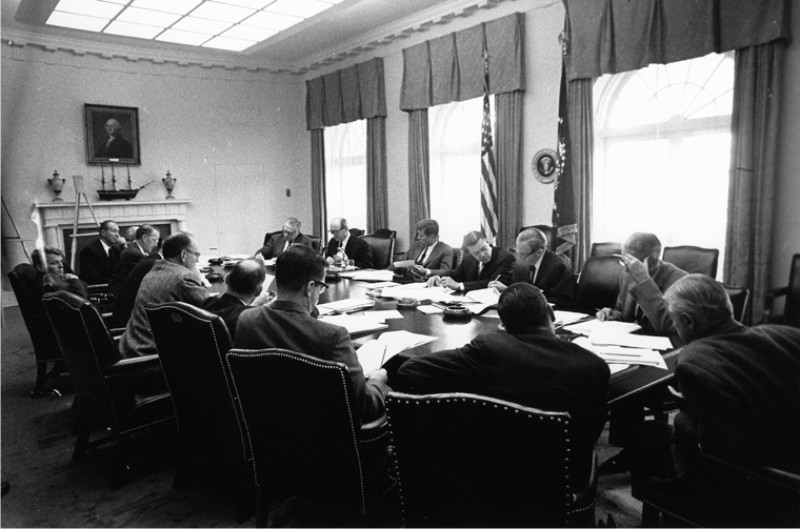
During the process of the meeting, the Joint Chiefs of Staff agreed that a full-scale attack and invasion was the only solution. Kennedy was doubtful that this was the only solution, saying:
“They, no more than we, can let these things go by without doing something. They can't, after all their statements, permit us to take out their missiles, kill a lot of Russians, and then do nothing. If they don't take action in Cuba, they certainly will in Berlin.” Opposed to the Joint Chiefs plan, Secretary of Defense Robert McNamara supported the naval blockade as a strong but limited military action that left the U.S. in control. Per international law a blockade is an act of war, but the Kennedy administration did not feel themselves limited, thinking the USSR would not be provoked to attack by a mere blockade.
Blockade or Quarantine?
In customary international practice, a blockade stops all shipments into the blockaded area, and is considered an act of war. Quarantines are more selective, as, in this case, being limited to offensive weapons. Admiral George Whelan Anderson, Jr., Chief Naval Officer, was asked to draw up a plan of action for the blockading of Cuba. While Anderson’s original U.S. Navy paper did use the term "blockade,"
This initially was to involve a naval blockade against offensive weapons within the framework of the Organization of American States and the Rio Treaty. Such a blockade might be expanded to cover all types of goods and air transport. The action was to be backed up by surveillance of Cuba. CNO's scenario was followed closely in later implementing the quarantine.
Admiral Anderson's paper, by differentiating between the quarantine of offensive weapons versus all materials, indicated that a classic blockade was not the original intention. Since it would take place in international waters, President John F. Kennedy obtained the approval of the OAS for military action under the hemispheric defense provisions of the Inter-American Treaty of Reciprocal Assistance (i.e., the Rio Treaty).
Latin America’s Participation
The U.S. was not the only nation to participate in the quarantine of Cuba. Argentina supplied two destroyers, two Venezuelan destroyers and one submarine reported for duty, the Government of Trinidad and Tobago offered the use of Chaguaramas Naval Base, and the Dominican Republic had made available one escort ship. Colombia was reported ready to furnish units and the Argentine Air Force informally offered three SA-16 aircraft in addition to forces already committed to the quarantine operation.
At 7 p.m. October 22, President Kennedy delivered a televised radio address announcing the discovery of the missiles and the next day, President Kennedy signed the Proclamation for Interdiction of the Delivery of Offensive Weapons to Cuba.
Khrushchev’s Reply
In an exchange of telegrams between Khrushchev and Bertrand Russell a political activist and pacifist, where Khrushchev warned that the United States' "pirate action" would lead to war. However this was followed at 9:24 p.m. by a telegram from Khrushchev to Kennedy which was received at 10:52 p.m., in which Khrushchev stated that "if you coolly weigh the situation which has developed, not giving way to passions, you will understand that the Soviet Union cannot fail to reject the arbitrary demands of the United States", and that the Soviet Union views the blockade as "an act of aggression" and their ships will be instructed to ignore it.
Naval Actions
At 7:15 a.m. on October 25, the USS Essex and USS Gearing attempted to intercept the Bucharest but failed to do so. Fairly certain the tanker did not contain any military material, it was allowed through the blockade. Later that day, at 5:43 p.m., the commander of the blockade effort ordered the USS Kennedy to intercept and board the Lebanese freighter Marcula. This took place the next day, and the Marcula was cleared through the blockade after its cargo was checked.
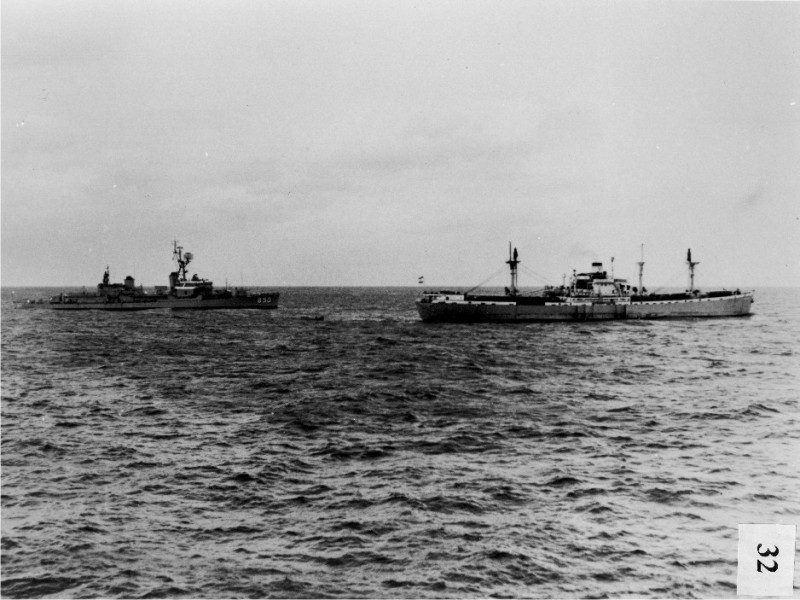
October 26, 1962: The U.S. destroyer Joseph P. Kennedy stops, boards and inspects the Marucla, a dry-cargo ship of Lebanese registry under Soviet charter to Cuba.
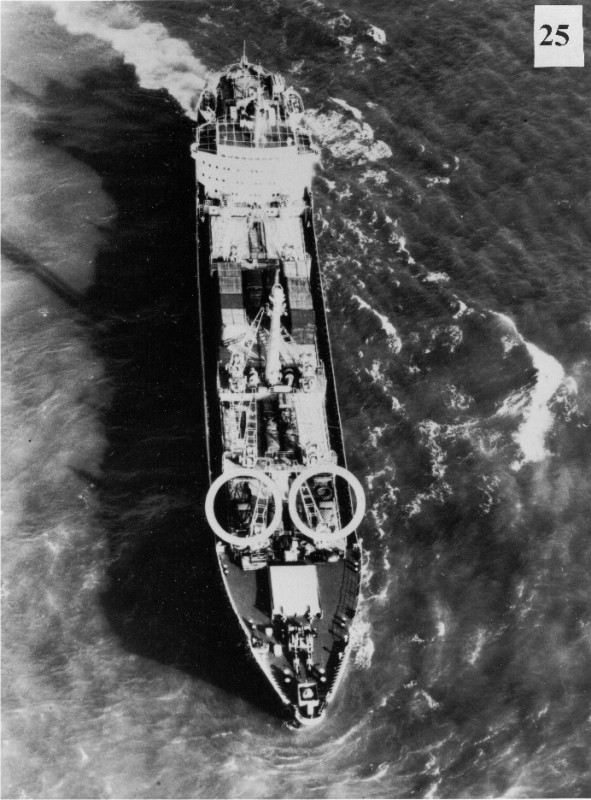
October 24, 1962: Low-level photograph of the Poltava, turning back towards Moscow, carrying IRBM missiles (circled are the IRBM launch rings on trucks).
At 5:00 p.m. Dean Rusk announced that the missiles in Cuba were still actively being worked on. This report was later verified by a CIA report that suggested there had been no slow-down at all. In response, Kennedy issued Security Action Memorandum 199, authorizing the loading of nuclear weapons onto aircraft under the command of SACEUR (which had the duty of carrying out the first air strikes on the Soviet Union).
The next morning, Kennedy informed the executive committee that he believed only an invasion would remove the missiles from Cuba. However, he was persuaded to give the matter time and continue with both military and diplomatic pressure. He agreed and ordered the low-level flights over the island to be increased from two per day to once every two hours. He also ordered a crash program to institute a new civil government in Cuba if an invasion went ahead.
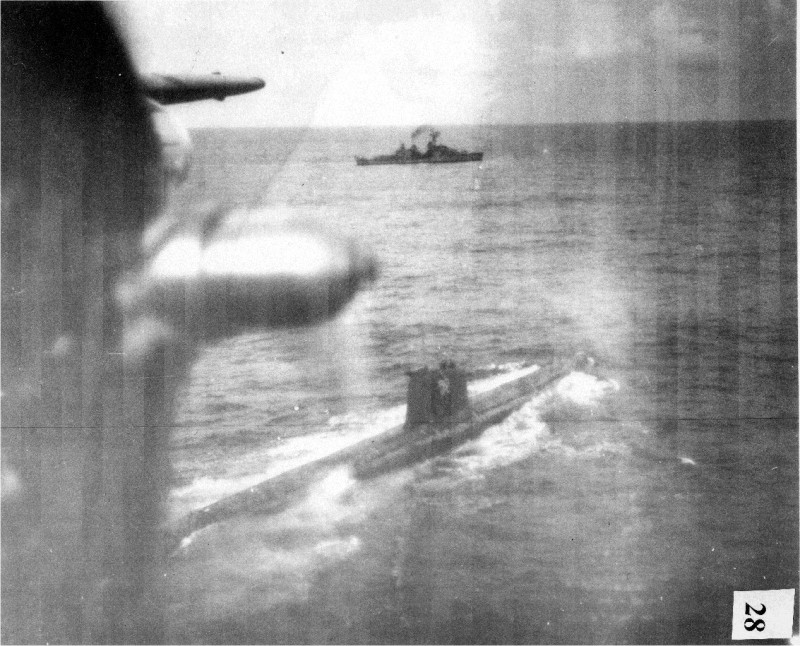
October 25, 1962: U.S. Navy surveillance of first Soviet F-class submarine to surface near the quarantine line (conning tower number 945, Soviet fleet number B-130, commanded by Shumkov).
At this point the crisis was at a stalemate. The USSR had shown no indication that they would back down and had made several comments to the contrary. The U.S. had no reason to believe otherwise and was in the early stages of preparing for an invasion, along with a nuclear strike on the Soviet Union in case they responded militarily, which was assumed. On October 26, 1962 the USS Beale dropped depth-charges an unidentified submarine which was in fact Soviet and armed with nuclear weapons.
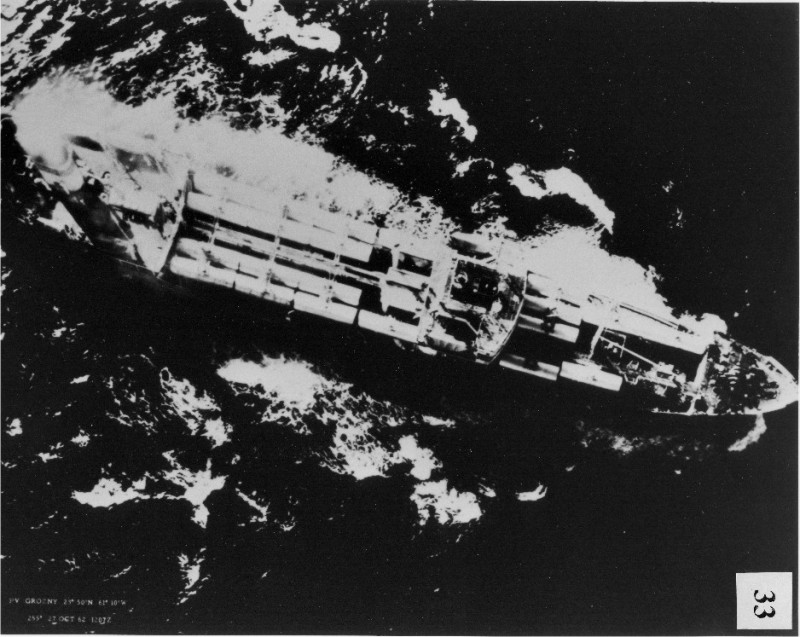
October 27, 1962: The Soviet ship Grozny crosses the quarantine line, but stops after U.S. Navy ships fire star shells across her bow.
Shoot Down of the U-2 and Attack on a RF-8A Crusader
On the morning of October 27, a Lockheed U-2 piloted by Major Rudolf Anderson, USAF had departed the U-2 forward operating location at McCoy AFB, Florida. At approximately 12:00pm Eastern Standard Time, the aircraft was shot down by an S-75 Dvina (NATO designation SA-2 Guideline) SAM emplacement in Cuba, increasing the stress in negotiations between the USSR and the U.S. It was later learned that the decision to fire was made locally by an undetermined Soviet commander on his own authority. Later that day, at about 3:41 p.m., several U.S. Navy RF-8A Crusader reconnaissance aircraft on low-level photoreconnaissance missions were fired upon, and one was hit by a 37 mm shell but managed to return to base.
At 4 p.m. Kennedy recalled the executive committee to the White House and ordered that a message immediately be sent to U Thant asking if the Soviets would "suspend" work on the missiles while negotiations are carried out. During this meeting, Maxwell Taylor delivered the news that the U-2 had been shot down. Kennedy had earlier claimed he would order an attack on such sites if fired upon, but he decided to leave the matter unless another attack was made.
In an interview 40 years later, McNamara remembers:
“We had to send a U-2 over to gain reconnaissance information on whether the Soviet missiles were becoming operational. We believed that if the U-2 was shot down that—the Cubans didn't have capabilities to shoot it down, the Soviets did—we believed if it was shot down, it would be shot down by a Soviet surface-to-air-missile unit, and that it would represent a decision by the Soviets to escalate the conflict. And therefore, before we sent the U-2 out, we agreed that if it was shot down we wouldn't meet, we'd simply attack. It was shot down on Friday [...]. Fortunately, we changed our mind, we thought "Well, it might have been an accident, we won't attack." Later we learned Khrushchev reasoned just as we did: we send over the U-2, if it was shot down, he reasoned we would believe it was an intentional escalation. And therefore, he issued orders to Pliyev, the Soviet commander in Cuba, to instruct all of his batteries not to shoot down the U-2.”
The Secret Negotiations and the End of the Crisis
Through secret negotiations and late night communications, and much deliberation between the Soviet Union and Kennedy's cabinet, Kennedy agreed to remove all missiles set in Turkey on the border of the Soviet Union in exchange for Khrushchev removing all missiles in Cuba.
At 9 a.m. on October 28, a new message from Khrushchev was broadcast on Radio Moscow. Khrushchev stated "the Soviet government, in addition to previously issued instructions on the cessation of further work at the building sites for the weapons, has issued a new order on the dismantling of the weapons which you describe as 'offensive' and their crating and return to the Soviet Union."
Kennedy immediately responded, issuing a statement calling the letter "an important and constructive contribution to peace". He continued this with a formal letter: "I consider my letter to you of October twenty-seventh and your reply of today as firm undertakings on the part of both our governments which should be promptly carried out... The U.S. will make a statement in the framework of the Security Council in reference to Cuba as follows: It will declare that the United States of America will respect the inviolability of Cuban borders, its sovereignty, that it take the pledge not to interfere in internal affairs, not to intrude themselves and not to permit our territory to be used as a bridgehead for the invasion of Cuba, and will restrain those who would plan to carry an aggression against Cuba, either from U.S. territory or from the territory of other countries neighboring to Cuba."
The practical effect of this Kennedy-Khrushchev Pact was that it effectively strengthened Castro's position in Cuba in that he would not be invaded by the United States. It is possible that Khrushchev only placed the missiles in Cuba to get Kennedy to remove the missiles from Turkey and that the Soviets had no intention of resorting to nuclear war when they were out-gunned by the Americans. However because the withdrawals from Turkey were not made public at the time, Khrushchev appeared to have lost the conflict and become weakened. The perception was that Kennedy had won the contest between the superpowers and Khrushchev had been humiliated. However this is not entirely the case as both Kennedy and Khrushchev took every step to avoid full out conflict despite the pressures of people in their governments. Khrushchev would hold on to power for another two years.
U.S. Ships involved in the Cuban Quarantine
Abbot (DD 629), 11 - 22 Nov 62.
Ability (MSO 519), 6 - 24 Nov 62.
Aggressive (MSO 422), 28 Oct - 11 Nov 62.
Agile (MSO 421), 28 Oct - 11 Nov 62.
Aldebaran (AF 10), 24 Oct - 6 Nov 62.
Algol (AKA 54), 24 Oct - 16 Dec 62.
Allagash (AO 97), 6 Nov - 21 Dec 62.
Allan M. Sumner (DD 692), 24 Oct - 21 Nov 62.
Altair (AKS 32), 11 - 28 Nov 62.
Bache (DD 470), 25 Oct - 5 Nov 62.
Barry (DD 933), 24 Oct - 1 Nov 62.
Barton (DD 722), 24 Oct - 30 Nov 62.
Basilone (DD 824), 24 Oct - 18 Nov 62.
Bayfield (APA 33), 8 Nov - 5 Dec 62.
Beale (DD 471), 25 Oct - 5 Nov 62.
Bearss (DD 654), 4 - 16 Nov 62.
Beatty (DD 756), 16 - 24 Nov 62.
Belle Grove (LSD 2), 8 Nov - 5 Dec 62.
Bexar (APA 237), 8 Nov - 5 Dec 62.
Biddle (DDG 5), 24 Oct - 21 Nov 62.
Bigelow (DD 942), 24 Oct - 21 Nov 62.
Blandy (DD 943), 24 Oct - 1 Nov 62.
Bordelon (DD 881), 24 Oct - 22 Nov 62; 3 - 21 Dec 62.
Borie (DD 704), 24 Oct - 1 Dec 62.
Boxer (LPH 4), 24 Oct - 6 Dec 62.
Bristol (DD 857), 4 Nov - 3 Dec 62.
Brough (DE 148), 25 Oct - 1 Dec 62.
Brownson (DD 868), 28 Oct - 18 Nov 62.
Cabildo (LSD 16), 8 Nov - 5 Dec 62.
Calcaterra (DER 390), 31 Oct - 14 Nov 62.
Caloosahatchee (AO 98), 16 Nov-7 Dec 62.
Cambria (APA 36), 24 Oct - 5 Dec 62.
Canberra (CAG 2), 24 Oct - 6 Nov 62; 19 - 22 Nov 62.
Canisteo (AO 99), 19 Nov - 18 Dec 62.
Capricornus (AKA 57), 24 Oct - 10 Dec 62.
Carter Hall (LSD 3), 8 Nov - 5 Dec 62.
Casa Grande (LSD 13), 24 Oct - 5 Dec 62.
Charles F. Adams (DDG 2), 24 Oct - 30 Nov 62.
Charles H. Roan (DD 853), 27 Oct - 24 Nov 62.
Charles P. Cecil (DDR 835), 29 Oct - 6 Dec 62.
Charles R. Ware (DD 865), 24 Oct - 21 Nov 62.
Charles S. Sperry (DD 697), 24 Oct - 1 Nov 62.
Cheboygan County (LST 533), 24 Oct - 15 Dec 62.
Chikaskia (AO 54), 24 Oct - 20 Nov 62.
Chilton (APA 38), 24 Oct - 7 Dec 62.
Claud Jones (DE 1033), 24 Oct - 22 Nov 62.
Colonial (LSD 18), 8 Nov - 5 Dec 62.
Conway (DD 507), 25 Oct - 5 Nov 62.
Cony (DD 508), 25 Oct - 5 Nov 62.
Cook (APD 130), 8 Nov - 5 Dec 62.
Corry (DDR 817), 24 Oct - 12 Nov 62; 18 - 21 Nov 62.
Dahlgren (DLG 12), 27 Oct - 11 Nov 62.
Damato (DD 871), 24 Oct - 4 Nov 62.
Davis (DD 937), 13 - 24 Nov 62.
Decatur (DD 936), 4 Nov - 7 Dec 62.
Denebola (AF 56), 11 - 22 Nov 62.
Desoto County (LST 1171), 24 Oct - 6 Dec 62.
Dodge County (LST 722), 24 Oct - 15 Dec 62.
Dewey (DLG 14), 24 Oct - 12 Nov 62.
Dupont (DD 941), 26 Oct - 22 Nov 62.
Duval County (LST 758), 24 Oct - 15 Dec 62.
Dyess (DDR 880), 3 - 23 Dec 62.
Earl B. Hall (APD 107), 24 Oct - 7 Dec 62.
Eaton (DD 510), 25 Oct - 5 Nov 62.
Eldorado (AGC 11), 8 Nov - 5 Dec 62.
Elokomin (AO 55), 24 Oct - 23 Nov 62.
English (DD 696), 24 Oct - 24 Nov 62.
Enterprise (CVAN 65), 24 Oct - 3 Dec 62. [With aviation squadrons VF-33, VF-102, VA-34 (Flew aboard 26 Oct, transferred to Independence 19 Nov), VA-35, VA-66, VA-76, VMA-225, VAW-12 Det 14.]
Escape (ARS 6), 24 Oct - 5 Dec 62.
Essex (CVS 9), 24 Oct - 15 Nov 62. [With aviation squadrons VS-34, VS-39, VA-43 Det 9, VAW-12 Det 9, HS-9.]
Eugene A. Greene (DD 711), 24 Oct - 20 Nov 62.
Fiske (DDR 842), 24 Oct - 1 Dec 62.
Forrest B. Royal (DD 872), 24 Oct - 21 Nov 62.
Fort Snelling (LSD 30), 24 Oct - 6 Dec 62.
Francis Marion (APA 249), 24 Oct - 7 Dec 62.
Furse (DD 882), 24 Oct - 22 Nov 62.
Gainard (DD 706), 18-20 Nov 62.
Gearing (DD 710), 24 - 30 Oct 62.
Grand Canyon (AD 28), 3 Nov - 1 Dec 62.
Grant County (LST 1174), 24 - 7 Dec 62.
Great Sitkin (AE 17), 24 Oct - 15 Dec 62.
Gunston Hall (LSD 5), 8 Nov - 5 Dec 62.
Hank (DD 702), 24 Oct - 26 Nov 62.
Harlan R. Dickson (DD 708), 4 Nov - 5 Dec 62.
Harwood (DD 861), 24 Oct - 21 Nov 62.
Hawkins (DDR 873), 24 Oct - 1 Dec 62.
Haynsworth (DD 700), 24 Oct - 14 Nov 62
Henley (DD 762), 27 Oct - 22 Nov 62.
Henrico (APA 45), 8 Nov - 5 Dec 62.
Hermitage (LSD 34), 7-23 Dec 62.
Hissem (DER 400), 24 Oct - 5 Nov 62.
Hoist (ARS 40), 27 Oct - 27 Nov.
Holder (DD 819), 1 - 18 Nov 62.
Hugh Purvis (DD 709), 28 Oct - 18 Nov 62.
Hyades (AF 28), 24 Oct - 15 Dec 62.
Independence (CVA 62), 24 Oct - 20 Nov 62. [With aviation squadrons VF-13, VF-84, VA-64 (Shifted to Enterprise 19 Nov), VA-72, VA-75 (Shifted to Guantanamo 22 Nov), VAH-11 Det 8, HU-2 Det 62, VAW-33 Det 62.
Ingraham (DD 694), 6-10 Nov 62.
Iwo Jima (LPH 2), 8 Nov - 5 Dec 62.
John King (DDG 3), 7 Nov - 6 Dec 62.
John Paul Jones (DD 932), 4 Nov - 5 Dec 62.
John R. Perry (DE 1034), 24 Oct - 22 Nov 62.
John R. Pierce (DD 753), 24 Oct - 2 Dec 62.
Johnston (DD 821), 10-31 Dec 62.
John W. Weeks (DD 701), 24 Oct - 14 Nov 62.
Joseph P. Kennedy Jr (DD 850), 24 Oct - 5 Dec 62.
Kankakee (AO 39), 24 Oct - 4 Dec 62.
Kaskaskia (AO 27), 24 Oct - 20 Nov 62.
Keppler (DD 765), 24 Oct - 1 Nov 62.
Kiowa (ATF 72), 20 Nov - 1 Dec 62.
Kretchmer (DER 329), 27 Nov - 20 Dec 62.
Lake Champlain (CVS 39), 18 Nov - 5 Dec 62. [With aviation squadrons VS-22, VS-32, VAW-33 Det 39, HS-5, HU-2 Det 39.]
Lawrence (DDG 4), 24 Oct - 6 Dec 62.
Leary (DDR 879), 24 Oct - 22 Nov 62.
Liddle (APD 60), 24 Oct - 6 Dec 62.
Lindenwald (LSD 6), 24 Oct - 5 Dec 62.
Lorain County (LST 1177), 24 Oct - 7 Dec 62.
Lowry (DD 770), 24 Oct - 8 Nov 62; 17-30 Nov 62.
Luiseno (AFT 156), 19 Nov - 9 Dec 62.
Mac Donough (DLG
 , 24 Oct - 20 Nov 62.
, 24 Oct - 20 Nov 62.Maloy (DE 791), 6-29 Nov 62.
Manley (DD 940), 24 Oct - 24 Nov 62.
Marias (AO 57), 12 - 20 Nov 62.
Mathews (AKA 96), 8 Nov - 5 Dec 62.
Mazama (AE 9), 24 Oct - 2 Dec 62.
Mc Caffery (DD 860), 24 Oct - 21 Nov 62.
Merrick (AKA 97), 8 Nov - 5 Dec 62.
Mills (DER 383), 24 - 31 Oct 62.
Monrovia (APA 31), 24 Oct - 16 Dec 62.
Mosopelea (ATF 158), 8 Nov - 1 Dec 62.
Mount McKinley (AGC 7), 24 Oct - 10 Dec 62.
Mullinnix (DD 944), 24 Oct - 6 Dec 62.
Murray (DD 576), 25 Oct - 5 Nov 62.
Neosho (AO 143), 24 Oct - 22 Nov 62.
Nespelen (AOG 55), 25 - 27 Nov 62.
New (DD 818), 2-19 Nov 62.
Newman K. Perry (DDR 883), 24 Oct - 22 Nov 62; 3-21 Dec 62.
Newport News (CA 148), 24 Oct - 21 Nov 62.
Nitro (AE 23), 13-23 Nov 62.
Noble (APA 218), 8 Nov - 5 Dec 62.
Norfolk (DL 1), 24 Oct - 21 Nov 62.
Norris (DD 859), 4 Nov - 5 Dec 62.
Oglethorpe (AKA 100), 24 Oct - 5 Dec 62.
O'Hare (DDR 889), 24 Oct - 3 Dec 62.
Okanogan (APA 220), 8 Nov - 5 Dec 62.
Okinawa (LPH 3), 24 Oct - 5 Dec 62.
Opportune (ARS 41), 25 Nov - 4 Dec 62.
Oxford (AG 159), 29 Oct - 15 Dec 62.
Page County (LST 1076), 8 Nov - 5 Dec 62.
Paiute (ATF 159), 5 Nov - 2 Dec 62.
Papago (ATF 160), 24 Oct -22 Nov 62.
Pawcatuck (AO 108), 5 Nov - 7 Dec 62.
Peregrine (AG 176), 26 Oct - 5 Nov 62; 26 - 29 Nov 62.
Peterson (DE 152), 25 Oct - 1 Dec 62.
Plymouth Rock (LSD 29), 24 Oct - 7 Dec 62.
Pocono (AGC 16), 12 Nov - 3 Dec 62.
Point Defiance (LSD 31), 8 Nov - 5 Dec 62.
Purdy (DD 734), 17 - 24 Nov 62.
Randolph (CVS 15), 24 Oct - 7 Nov 62; 23 - 30 Nov 62. [With aviation squadrons VS-26, VS-36, VAW-12 Det 36, HS-7.]
Rankin (AKA 103), 26 Oct - 11 Dec 62.
Renville (APA 227), 8 Nov - 5 Dec 62.
Rhodes (DER 384), 24 Oct - 26 Nov 62; 21 - 31 Dec 62.
Rich (DD 820), 2 - 18 Nov 62.
Richard E. Kraus (DD 849), 29 Oct - 21 Nov 62.
Rigel (AF 58), 9 - 22 Nov 62.
Rival (MSO 468), 24 Nov - 31 Dec 62.
Robert A. Owens (DD 827), 27 Oct - 20 Nov 62.
Robert L. Wilson (DD 847), 24 Oct - 3 Nov 62.
Rockbridge (APA 228), 24 Oct - 16 Dec 62.
Roy O. Hale (DER 336), 14-16 Nov 62.
Rush (DDR 714), 24 Oct - 1 Dec 62.
Sabine (AO 25), 24 Oct - 18 Nov 62.
Salamonie (AO 26), 1 - 24 Nov 62.
Salinan (ATF 161), 24 Oct - 10 Dec 62.
Salute (MSO 470), 29 Nov - 31 Dec 62.
Samuel B. Roberts (DD 823), 24 Oct - 3 Nov 62.
Sandoval (APA 194), 24 Oct - 18 Dec 62.
Saratoga (CVA 60), 3-20 Dec 62. [With aviation squadrons VF-32, VA-36, VAW-34.]
Saufley (DD 465), 24 Oct - 22 Nov 62.
Sea Poacher (SS 406), 29 Nov - 14 Dec 62.
Sellers (DDG 11), 24 Oct - 21 Nov 62.
Seneca (ATF 91), 13 Nov - 15 Dec 62.
Shadwell (LSD 15), 24 Oct - 5 Dec 62.
Shakori (AFT 162), 12 Nov - 2 Dec 62.
Soley (DD 707), 24 Oct - 2 Dec 62.
Spiegel Grove (LSD 32), 24 Oct - 30 Nov 62.
Steinaker (DDR 863), 24 Oct - 14 Nov 62; 20-22 Nov 62.
Stickell (DDR 888), 24 Oct - 6 Dec 62.
Suffolk County (LST 1173), 24 Oct - 16 Dec 62.
Talbot County (LST 1153), 24 Oct - 16 Dec 62.
Terrebonne Parish (LST 1156), 15 Nov - 16 Dec 62.
The Sullivans (DD 537), 17 Nov - 17 Dec 62.
Thetis Bay (LPH 6), 24 Oct - 7 Dec 62.
Thomas J. Gary (DER 326), 15-27 Nov 62.
Thomaston (LSD 28), 8 Nov - 5 Dec 62.
Thuban (AKA 19), 17 Nov - 8 Dec 62.
Traverse County (LST 1160), 24 Oct - 6 Dec 62.
Truckee (AO 147), 24 Oct - 5 Dec 62.
Tutuila (ARG 4), 20 Nov - 7 Dec 62.
Union (AKA 106), 8 Nov - 5 Dec 62.
Utina (ATF 168), 28 Nov - 15 Dec 62.
Uvalde (AKA 88), 24 Oct - 4 Dec 62.
Vermilion (AKA 107), 24 Oct - 7 Dec 62.
Vesole (DDR 878), 24 Oct - 22 Nov 62; 3 - 21 Dec 62.
Vulcan (AR 5), 30 Oct - 29 Nov 62.
Wahkiakum County (LST 1162), 24 Oct - 7 Dec 62.
Wallace L. Lind (DD 703), 24 Oct - 22 Nov 62.
Waller (DD 466), 25 Oct - 5 Nov 62.
Walworth County (LST 1164), 24 Oct - 5 Dec 62.
Washburn (AKA 108), 8 Nov - 5 Dec 62.
Wasp (CVS 18), 2 - 19 Nov 62. [With aviation squadrons VS-28, VS-31, VS-64 Det 18, VAW-33 Det 18, HS-11, HU-2 Det 18, VRC-40.]
Whetstone (LSD 27), 8 Nov - 5 Dec 62.
Willard Keith (DD 775), 24 Oct - 15 Nov 62.
William C. Lawe (DD 763), 24 Oct - 21 Nov 62.
William M. Wood (DDR 715), 28 Oct - 24 Nov 62; 10 - 24 Dec 62.
Willis A. Lee (DL 4), 7 - 21 Nov 62.
Windlass (ARSD 4), 21 - 24 Nov 62.
Witex (DD 848), 24 Oct - 1 Nov 62; 16 - 20 Nov 62.
Wood County (LST 1178), 24 Oct - 7 Dec 62.
Wrangell (AE 12), 24 Oct - 20 Nov 62.
Yancey (AKA 93), 24 Oct - 7 Dec 62.
York County (LST 1175), 24 Oct - 5 Dec 62.
Yosemite (AD 19), 7 Nov - 9 Dec 62.
Zellars (DD 777), 24 Oct - 21 Nov 62).
















